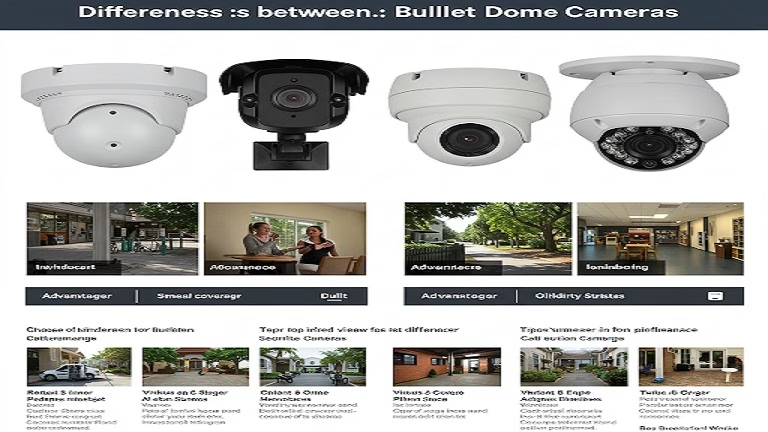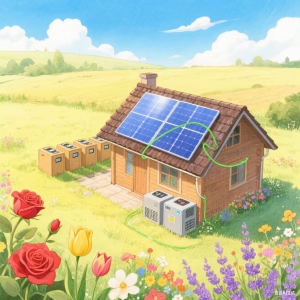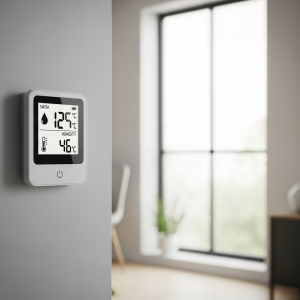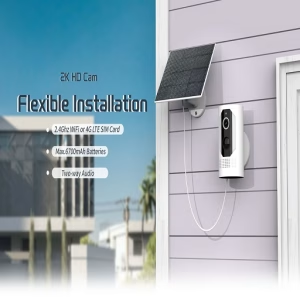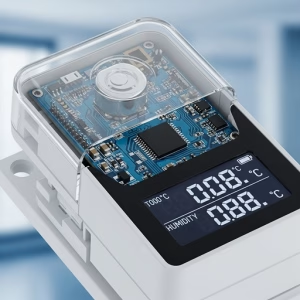Bullet vs Dome Cameras: Choosing the Right Eye for Your Surveillance Needs
Bullet VS Dome cameras:In the ever-evolving landscape of security, choosing the right surveillance camera is paramount to safeguarding your property, assets, and peace of mind. Two of the most prevalent types of security cameras on the market are bullet cameras and dome cameras. While both serve the fundamental purpose of capturing video footage, they differ significantly in their design, functionality, and suitability for various applications. Understanding these distinctions is crucial for making an informed decision that aligns with your specific security requirements.
This comprehensive guide will delve into the nuances of bullet vs dome cameras, exploring their respective advantages and disadvantages, and ultimately helping you determine which type is the optimal choice for your unique needs. We’ll cover everything from their physical attributes and installation considerations to their performance capabilities and ideal deployment scenarios.
Understanding the Fundamentals: Bullet and Dome Cameras Defined
Before we dive into a detailed comparison, let’s establish a clear understanding of what each type of camera entails:
Bullet Cameras:
True to their name, bullet cameras feature a distinctive long, cylindrical shape, resembling a rifle bullet. This design is not merely aesthetic; it often contributes to their functionality and suitability for specific environments.
- Key Characteristics:
- Shape: Elongated, cylindrical housing.
- Mounting: Typically mounted using a bracket that allows for directional adjustment.
- Lens: Often features a fixed or varifocal lens, sometimes with the option for interchangeable lenses.
- Weatherproofing: Generally designed with robust housings that offer good protection against dust, rain, and other environmental elements, making them suitable for outdoor use.
- Infrared (IR) Capabilities: Often equipped with powerful IR LEDs for clear night vision, with the elongated design sometimes accommodating larger IR arrays for extended range.
- Deterrent Factor: Their conspicuous design can act as a visual deterrent to potential intruders.
Dome Cameras:
Dome cameras, on the other hand, are characterized by their dome-shaped housing that encases the camera lens and internal components. This design offers a more discreet and often more aesthetically pleasing appearance.
- Key Characteristics:
- Shape: Semi-spherical or dome-shaped housing.
- Mounting: Typically mounted flush against a ceiling or wall.
- Lens: Often features a fixed or varifocal lens, with the lens concealed behind the dome cover.
- Vandal Resistance: The dome housing can offer a degree of protection against vandalism, as it’s difficult to determine the precise direction the camera is pointing and harder to tamper with the lens.
- Discreetness: Their less obtrusive design makes them ideal for environments where a visible security presence might be undesirable or aesthetically disruptive.
- Infrared (IR) Capabilities: Equipped with IR LEDs for night vision, although the range might sometimes be slightly less than comparable bullet cameras due to space constraints.
- 3-Axis Adjustment: Many dome cameras offer 3-axis adjustment, allowing for flexible aiming even after installation.
Head-to-Head Comparison: Bullet vs. Dome Cameras
Now, let’s delve into a detailed comparison across various critical factors:
1. Aesthetics and Visibility:
- Bullet Cameras: Their prominent, tubular design is highly visible, which can be a significant advantage for deterring potential criminals. The clear presence of a bullet camera signals that the area is under surveillance. However, in situations where discreet monitoring is preferred, their visibility can be a drawback.
- Dome Cameras: The dome shape is less conspicuous and blends more seamlessly into various environments, particularly indoor settings. This makes them ideal for situations where you want surveillance without drawing excessive attention. While less of a direct deterrent, their presence still serves a security function.
2. Installation and Mounting:
- Bullet Cameras: Typically come with a mounting bracket that allows for straightforward installation on walls, ceilings, or even poles. Adjusting the viewing angle is usually a simple process of loosening the bracket and repositioning the camera.
- Dome Cameras: Often require a slightly more involved installation process, especially when flush-mounted on a ceiling. However, many dome cameras offer 3-axis adjustment, providing greater flexibility in aiming the camera even after it’s mounted. This allows for precise coverage of the desired area.
3. Field of View and Lens Options:
- Bullet Cameras: Offer a wide range of lens options, including fixed focal length lenses for a specific field of view and varifocal lenses that allow you to manually adjust the zoom and focus to achieve the desired coverage. Some bullet cameras also support interchangeable lenses, providing even greater flexibility.
- Dome Cameras: Primarily utilize fixed or varifocal lenses. While interchangeable lens options exist for some higher-end dome cameras, they are less common than with bullet cameras due to the space constraints within the dome housing.
4. Night Vision Capabilities:
- Bullet Cameras: Often excel in night vision performance. Their elongated design can accommodate larger and more powerful infrared (IR) LED arrays, resulting in a longer and more effective night vision range. This makes them well-suited for outdoor areas or large indoor spaces that require surveillance in complete darkness.
- Dome Cameras: Also feature IR LEDs for night vision, but the range might sometimes be slightly shorter compared to similarly specified bullet cameras due to the limited space within the dome. However, advancements in IR technology continue to improve the night vision capabilities of dome cameras.
5. Weather and Vandal Resistance:
- Bullet Cameras: Typically boast robust, weatherproof housings with high IP (Ingress Protection) ratings, making them highly resistant to dust, rain, and extreme temperatures. This makes them an excellent choice for outdoor applications.
- Dome Cameras: While many dome cameras are also weatherproof and suitable for outdoor use, their dome-shaped housing offers an additional layer of protection against vandalism. The concealed lens is harder to tamper with or obscure, and the smooth, rounded surface makes it difficult to grip or damage. Some dome cameras are specifically designed with vandal-resistant materials and construction.
6. Discreetness and Aesthetics:
- Bullet Cameras: Their prominent appearance can be a deterrent but might be considered less aesthetically pleasing in certain environments.
- Dome Cameras: Their more subtle and less intrusive design blends well with various architectural styles and interior decors, making them a preferred choice for businesses, retail spaces, and residential areas where aesthetics are a concern.
7. Cost:
- Bullet Cameras: Generally, basic bullet cameras can be slightly more cost-effective than comparable dome cameras. However, the price difference often depends on the specific features, brand, and quality of the camera.
- Dome Cameras: Entry-level dome cameras might have a slightly higher price point, but the cost difference tends to narrow as you consider models with advanced features and higher specifications.
Ideal Applications for Bullet and Dome Cameras:
Understanding the strengths of each camera type allows us to identify their ideal applications:
Bullet Cameras are typically preferred for:
- Outdoor Perimeter Security: Their robust weatherproofing and long-range night vision make them excellent for monitoring property lines, driveways, and parking lots.
- Targeted Surveillance: With various lens options, they can be used to focus on specific areas or points of interest, such as entryways or loading docks.
- Areas Requiring Strong Deterrence: Their visible presence can act as a strong deterrent to potential intruders.
- Long-Distance Monitoring: Models with telephoto lenses can be used to monitor distant objects or areas.
Dome Cameras are typically preferred for:
- Indoor Surveillance: Their discreet design blends seamlessly into offices, retail stores, schools, and homes.
- Areas Prone to Vandalism: The dome housing offers better protection against tampering and vandalism.
- Wide-Angle Coverage: Many dome cameras offer wide-angle lenses suitable for monitoring large indoor spaces.
- Aesthetically Sensitive Environments: Their less obtrusive appearance is preferred in locations where aesthetics are important.
- Ceiling Mounting: Their design is ideal for flush mounting on ceilings, providing a wide overhead view.
Making the Right Choice:Bullet VS Dome cameras Key Considerations
When deciding between bullet and dome security cameras, carefully consider the following factors:
- Your Specific Security Needs: What are you trying to protect? What are the potential threats?
- The Environment: Will the camera be installed indoors or outdoors? What are the weather conditions?
- Desired Level of Visibility: Do you want a visible deterrent or a more discreet surveillance solution?
- Field of View Requirements: How wide of an area do you need to monitor? Do you need to focus on specific details?
- Night Vision Requirements: How well do you need to see in low-light or no-light conditions?
- Potential for Vandalism: Is the camera likely to be targeted for tampering or damage?
- Aesthetic Preferences: How important is the appearance of the camera in its surroundings?
- Budget: What is your budget for the security camera system?
Hybrid Solutions:
It’s important to note that you don’t necessarily have to choose exclusively between bullet and dome cameras. Many effective security systems utilize a combination of both types to provide comprehensive coverage. For example, you might use bullet cameras for perimeter security and dome cameras for indoor monitoring.
Conclusion: Choosing the Right Eye for Your Security Needs
Ultimately, the choice between bullet and dome security cameras depends on your unique circumstances and priorities. Both types offer valuable features and capabilities for effective surveillance. By carefully evaluating your specific needs, the environment where the cameras will be installed, and the advantages and disadvantages of each type, you can make an informed decision that will provide the optimal level of security and peace of mind.
Consider consulting with a professional security system integrator who can assess your property and recommend the most suitable camera types and placement strategies for your individual requirements. Investing in the right security camera system is an investment in your safety and the protection of what matters most.

